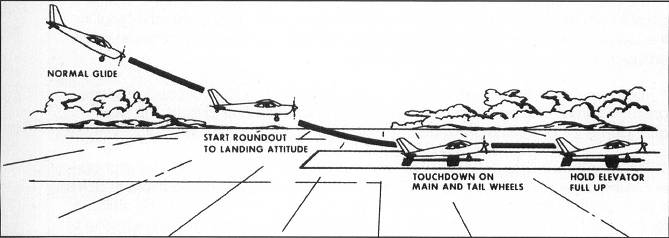Microsoft Flight Simulator Handbook
by Jonathan M. Stern
Tail Dragger Checkout
Flight Simulator comes equipped with the Sopwith Camel, a single-seat, tail dragger bi-plane. The airplane was flown as a fighter airplane in World War I. The Camel has relatively few instruments, as was true of most aircraft of its time (see Figure 7.5).

Some of the specifications of the Camel are contained in the following table:
| Length | 18 feet 9 inches |
| Height | 9 feet |
| Wingspan | 28 feet |
| Maximum Gross Weight | 1,482 pounds |
| Standard Empty Weight | 950 pounds |
| Absolute Ceiling | 19,000 feet |
| Maximum Operating Speed at 10,000 feet | 98 knots |
| Maximum Operating Speed at 15,000 feet | 92 knots |
| Stall Speed | 50 knots |
Basic instrumentation includes a tachometer, magnetic compass, airspeed indicator, altimeter, and inclinometer. The two devices that look like bicycle bells are the left and right magneto switch. The altimeter of the Camel's time was not of the sensitive variety, where it can be adjusted to the current barometric setting. The indications are not only less accurate but also more difficult to read because the face has a scale showing thousands of feet and a single needle display.
The biggest operational difference between the Cessna 182RG and the Camel comes from the fact that the Camel is a tail dragger. Accordingly, the checkout in the Camel focuses on the procedural and performance differences between a tail dragger airplane and a tricycle gear airplane.
The operational differences between a tail dragger and a tricycle gear airplane are in the areas of ground handling, takeoff, and landing. During flight, the gear arrangement is of little significance.
The most immediate noticeable difference in the tail dragger is that the pilot cannot see straight ahead while the airplane is at rest. The attitude of the airplane at rest is similar to the attitude during a climb at best angle of climb airspeed. This makes it far more difficult to maintain directional orientation while taxiing, at the beginning of the takeoff roll, and at the completion of the landing roll. Visual cues must be gained from peripheral vision and scanning to each side of the airplane. It is recommended that during taxi, the airplane be zigzagged along the taxi way to allow the pilot to observe other aircraft or other obstructions to safe passage. This type of taxiing must be done slowly, smoothly, and with great care.
Tail draggers have a far greater tendency to weathervane or ground loop than do tricycle gear airplanes. This tendency is greatest when the airplane is taxiing with a direct crosswind. It is more significant while taxiing downwind than upwind, because the flight controls are less effective with a tailwind. This makes it all the more important that the airplane's controls, while taxiing with a wind present, are set as described earlier in the book for taxiing.
During the takeoff roll, tail draggers tend to establish an appropriate takeoff attitude without pilot input (see Figure 7.6).
 Figure 7.6. During the takeoff roll, the tail wheel lifts slightly off the runway and assumes an appropriate takeoff attitude.
Figure 7.6. During the takeoff roll, the tail wheel lifts slightly off the runway and assumes an appropriate takeoff attitude.
The tail wheel lifts slightly off the runway, improving the forward visibility over the nose. Slight yoke back pressure may be applied at an appropriate liftoff speed to ease the airplane into the air.
The approach to landing is similar to that of a tricycle gear airplane. The touchdown, however, should be made on all three wheels (see Figure 7.7).
 Figure 7.7. The touchdown in a tail dragger is made on all three wheels.
Figure 7.7. The touchdown in a tail dragger is made on all three wheels.
After touchdown, the yoke should be held aft to keep the airplane's tail wheel on the ground. This enhances directional control through the steerable tail wheel and ensures that the airplane does not nose over onto its propeller.
Table of Contents
Previous Section: High Performance Checkout
Next Section: Corporate Jet Checkout
